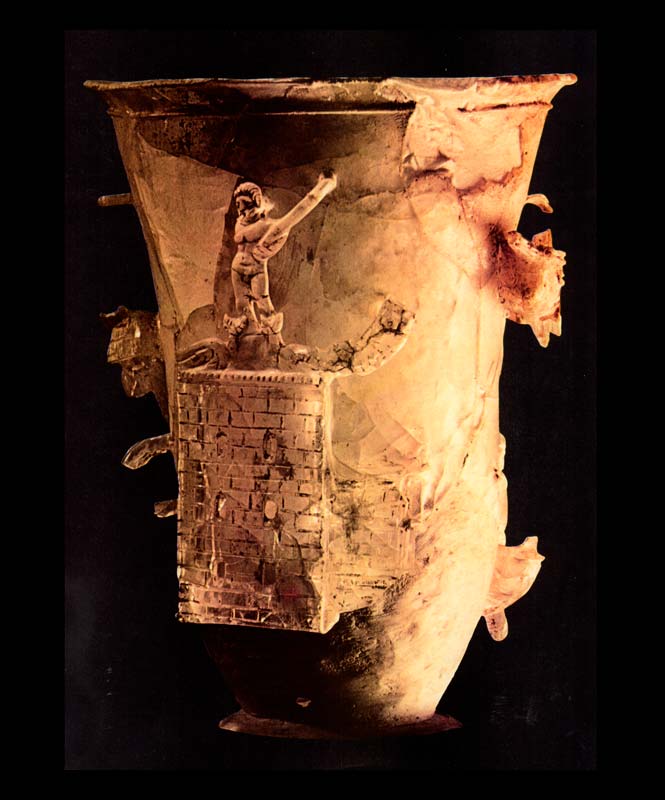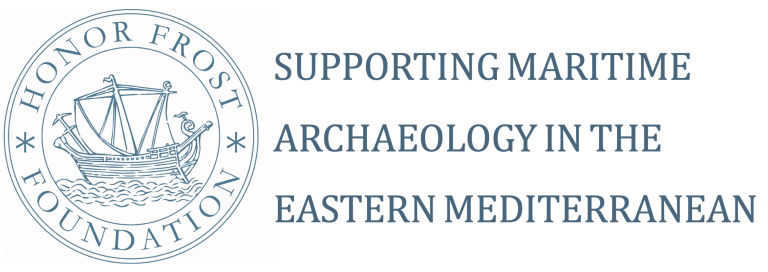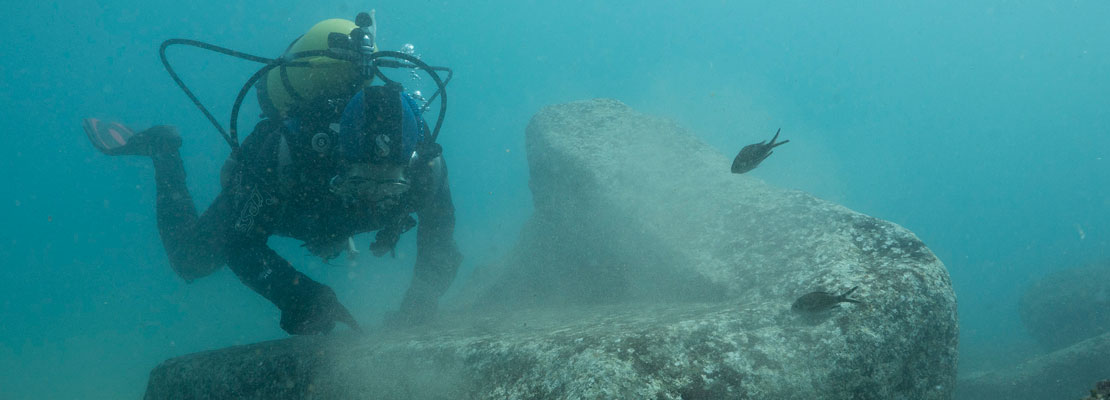
Underwater excavations on the Pharos site
Team leader : Isabelle Hairy
The site of the ancient Pharos or Lighthouse of Alexandria lies beneath the waters of the Mediterranean at the eastern tip of the Pharos peninsula, at the foot of the medieval fort of Qaitbay which, like the Pharos in its day, protected the entrance to the Great Harbour of Alexandria.
The archaeological site covers almost 1.6 hectares (2019 figures). It consists mainly of architectural blocks and fragments and statuary in hard stone (granite, quartzite, grano-diorite, greywacke, marble, limestone, etc.) mostly imported from southern Egypt, as well as lead, iron and bronze connecting elements used in the ancient buildings that stood on this site. The Lighthouse, the symbol of Alexandria, was erected at the eastern tip of the ancient island of Pharos, in front of the city, on the right as one entered the Great Harbour. This site, now submerged, covers around 3 hectares. It sank beneath the waters of the Mediterranean, along with the architectural ruins it bore, as a result of the subsidence that has affected Alexandria’s coasts since antiquity.
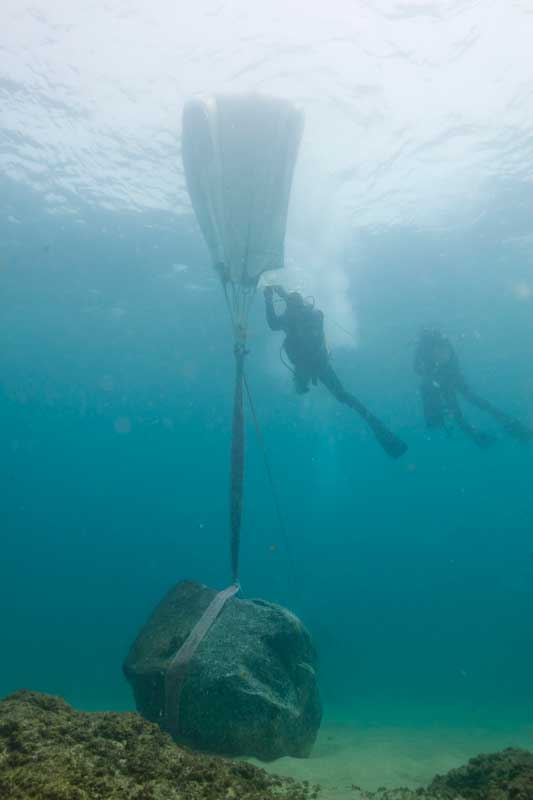
Since 1994, the CEAlex has been carrying out one or two excavation campaigns per year on the site, the duration of each depending essentially on the weather and the state of the sea.
For a long time, mapping and inventorying blocks and fragments were the main fieldwork activities, using conventional or novel means (triangulation, frame of reference, direct line topography, acoustic topography). Subsequent analysis led to the identification of the ruins of three different structures: the Lighthouse in the north-western part of the site, a Roman-era structure in the north-east and lastly, in the southern part of the site, a seawall to protect the coast along the north-eastern side of Qaitbay Fort, made of granite columns taken from the town’s ancient structures and re-cut for this purpose. The area of the Lighthouse ruins is notable for the imposing size of the architectural fragments and colossal statues, which can weigh up to 40 tonnes, and from which several reconstructions have been made of parts of Hellenistic or Pharaonic-style monuments (monumental doorways, masonry in the Cyclopean tradition, naos, colossal statues of royal couples, etc). In the north-east zone, the architectural elements studied are dated between the 2nd-1st century BC and the 4th century AD. Pieces of a monumental granite honorific column with an acanthus-leaf base was found here, a typical element of Hellenistic Alexandrian art that continued into the Roman period.
Since 2012, the CEAlex has embarked on a major programme to digitise the surface of the site using photogrammetry in order to obtain a precise 3D model, as well as to produce orthophotographs that will serve as a base for a new map of the site developed using QGIS. On 1 January 2020, the DSM (digital surface model) covered an area of roughly 10,250 m2, or around 65% of the archaeological site (15,910 m2), with 3040 blocks recorded in the database. These results make the underwater site one of the largest in the field of submerged architecture.
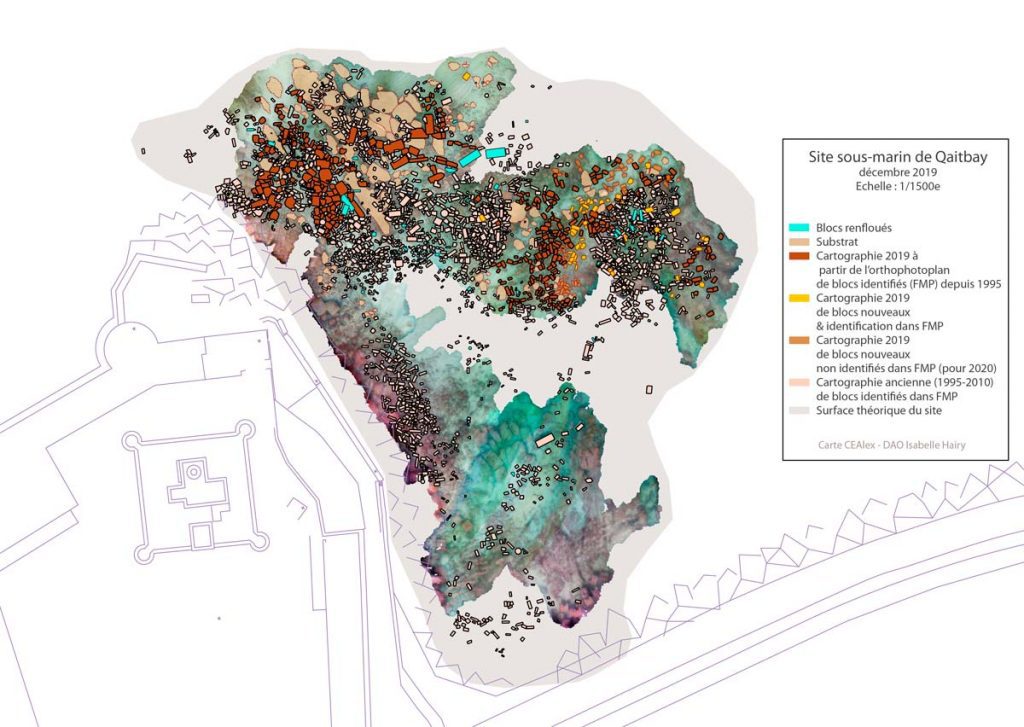
Similarly, traditional block surveying techniques have been replaced by 3D photogrammetry modelling of blocks and fragments. As of 1 January 2020, 154 digital duplicates of blocks or fragments are available, in various stages of completion; many of them are already being used in virtual architectural reconstructions.
Thirty-six pieces that were lifted from the sea in 1995 and 1996 can be seen in the centre of Alexandria, in the open-air museum at the Roman Theatre and in front of the Bibliotheca Alexandrina. Fragments of colossal statues are grouped together at the entrance to the site along with the presumed Pharos inscription, followed by architectural and epigraphic elements, sphinxes and obelisks.
Further reading:
Rapports de fouilles dans Bulletin de l’Institut d’Archéologie Orientale, de 1994 à 2011 et 2013 à 2019 en ligne sur le site de l’IFAO et sur celui du CEAlex.
M. Abdelaziz, M. Elsayed, « Underwater Photogrammetry digital surface model (DSM) of the submerged site of the ancient lighthouse bear Qaitbay fort in Alexandria, Egypt », in The International Archives of the Photogrammetry, Remote Sensing and Spatial Information Sciences, Volume XLII-2/W10, 2019 Underwater 3D Recording and Modelling “A Tool for Modern Applications and CH Recording”, 2–3 May 2019, Limassol, Cyprus.
J.-Y. Empereur
« La septième merveille du monde », Alexandrie redécouverte, Fayard, Paris, 2004, p. 63-87.
« Les fouilles sous-marines du CNRS à Alexandrie (Egypte) 1-Le site monumental de Qaitbay », Tropis VII : 7th International Symposium on Ship Construction in Antiquity (Pylos 1999), Athènes, 2002, p. 325-334
Rapports de fouille dans Bulletin de Correspondance Hellénique de 1995 à 2002
« Underwater Archaeological Investigations of the Ancient Pharos », in M.H. Hassan, N. Grimal et D. Nakashima (éd.), Underwater archaeology and coastal management : Focus on Alexandria, Coastal Managements sourcebooks 2, 2000, Paris, Unesco, p. 54-59
« Le phare d’Alexandrie », Les fabuleuses découvertes du XXe siècle, Dossarch 259, 2000, p. 144-150
J.-Y. Empereur, I. Hairy, « Honor Frost and the Pharos : the lighthouse of Alexandria », in L. Blue (éd.), In the Footsteps of Honor Frost, The life and legacy of a pioneer in maritime archaeology, Leyde, 2019, p. 183-198.
I. Hairy
« Fouilles sous-marines du site de Qaitbay : chronique archéologique des ruines du Phare », in CENIM (Les Cahiers Égypte Nilotique et Méditérranéenne), à paraître en 2021 (manuscrit déposé en février 2017)
« The Qaitbay Underwater Site at Alexandria, Egypt: The evolution of surveying techniques », ‘Under the Mediterranean’ The Honor Frost Foundation Conference on Mediterranean Maritime Archaeology (Nicosie, 2017) Short Report Series, 2020
« La médiation du patrimoine sous-marin: les moyens d’une cyber-exposition et d’une archéologie participative sur la fouille subaquatique du Qaitbay, Alexandrie, Égypte », in G. Vertecchi, C. Virlouvet (éd.), City, River, Littoral. The extension of transportation Infrastructure in Delta Areas, Special Issue of Riparia 2018, p. 83-94.
« Le Phare, lumière d’un empire sur le monde », in M.-D. Nenna (ed.), Alexandrie grecque, romaine et égyptienne, Dossiers d’Archéologie 374, mars/avril 2016, p. 18-23.
« Iskenderiye Feneri », In Antik Dünyanin 7 Harikasi, Aktüel Arkeoloji 59, 2017, p. 92-103.
« Pharos ou les origines de l’architecture euclidienne », in Y. Bacot (éd.), Méditerranées, Des grandes cités d’hier aux hommes d’aujourd’hui, cat. exp. Marseille 2013, Paris, Marseille, 2013, p. 82-85.
« Pharos, l’Égypte et Platon », in Images et modernité hellénistiques. Appropriation et représentation du monde d’Alexandre à César, 2007, p. 61-89.
« Mythes et réalité virtuelle : le cas d’Alexandrie », in Virtual Retrospect 2003, Proccedings of the conference Biarritz (France) November 6th-7th 2003, Bordeaux, Ausonius, 2004, p. 19-23
« Métrologie interprétative sur la statuaire de Qaitbay », KTEMA 29, 2004, p. 67-77
I. Hairy, M. El Sayed, M. Abdel Aziz, Ph. Soubias, « Le Phare. Un site immergé », in M.-D. Nenna (éd.), Alexandrie grecque, romaine et égyptienne, Dossiers d’Archéologie 374, mars/avril 2016.
G. Papatheodorou, M. Geraga, A. Chalari, M. Iatrou, G. Ferentinos, « Hellenistic Alexandria : a paleogeographic reconstruction based on marine geophysical data », in G. Soukiassian (éd.), Alexandria under the Mediterranean, Études Alexandrines 36, 2015, p. 27-61.


